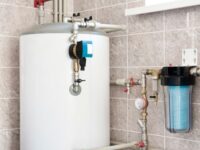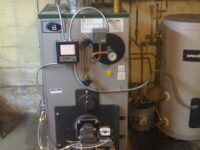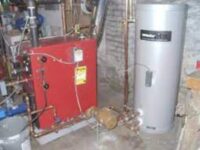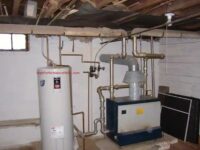Introduction: Understanding the Importance of Adding Water to a Steam Boiler
Steam boilers play a crucial role in many industrial and residential settings, providing heat and power through the generation of steam. To ensure their optimal performance and prevent potential hazards, it is essential to maintain the appropriate water level within the boiler. Adding water to a steam boiler is a routine task that requires careful attention to safety procedures and precise steps. In this article, we will guide you through the process, How To Add Water To A Steam Boiler? covering important considerations, troubleshooting tips, and best practices.
Safety First: Precautions Before Adding Water to a Steam Boiler
Before adding water to a steam boiler, it is crucial to prioritize safety. Here are some essential precautions to keep in mind:
- Ensure the boiler is cool: Wait for the boiler to cool down before attempting to add water. Hot surfaces can cause severe burns.
- Wear protective gear: Always wear protective gloves, safety goggles, and appropriate clothing when working with a steam boiler.
- Familiarize yourself with the boiler’s manual: Read and understand the manufacturer’s instructions and safety guidelines specific to your boiler model.
Identifying the Water Level Indicator: Locating and Interpreting the Boiler’s Water Level
Every steam boiler is equipped with a water level indicator, allowing you to monitor and maintain the water level. Locate the indicator, which is usually located on the side of the boiler. It typically consists of a glass tube or a transparent section with markings indicating the water level.
Shutting Off the Boiler: Ensuring Safety During the Water Addition Process
Before adding water, it is essential to shut off the boiler. Locate the main power switch or shut-off valve and turn it off. This prevents the boiler from operating while you add water and ensures your safety during the process.
Determining the Water Source: Selecting the Right Water Supply for Your Boiler
When adding water to a steam boiler, it is vital to use a suitable water source. The water should be clean, free of impurities, and preferably treated to prevent scale buildup. If available, consult your boiler’s manual for specific water quality recommendations. In general, using cold tap water is acceptable for residential boilers.

Purging the Boiler: Removing Impurities and Emptying Old Water
Before adding fresh water, it is advisable to purge the boiler to remove any impurities or stagnant water. Consult your boiler’s manual for detailed instructions on how to perform this task. Purging helps maintain the efficiency of the system and prevents potential damage from accumulated debris.
Opening the Feed Water Valve: Initiating the Water Addition Process
Locate the feed water valve, typically located near the bottom of the boiler. Slowly open the valve to allow water to enter the system. Take care not to open it too quickly, as rapid water flow can cause water hammer, a phenomenon that can damage the boiler.
Monitoring the Water Level: Maintaining the Proper Water Level in the Boiler
As you add water, monitor the water level indicator. Slowly add water until the level reaches the recommended mark. Take your time and avoid overfilling, as excessive water can lead to operational issues and potentially damage the boiler.
Controlling the Water Flow: Adjusting the Feed Water Rate
If your boiler is equipped with a manual feed water control, you can adjust the feed rate to maintain the desired water level. Consult your boiler’s manual for specific instructions on adjusting the feed water rate.

Avoiding Overfilling: Preventing Excessive Water in the Boiler
Overfilling a steam boiler can result in operational problems and potential damage. Carefully monitor the water level indicator and avoid adding water beyond the recommended mark.
Securing the Feed Water Valve: Closing the Valve After Water Addition
After reaching the desired water level, it is crucial to close the feed water valve. Turning off the valve prevents additional water from entering the boiler and helps maintain the proper water-to-steam ratio for efficient operation.
Testing the Water Level Controls: Verifying the Functionality of the Controls
To ensure the water level controls are functioning correctly, it is advisable to conduct periodic tests. Follow the manufacturer’s instructions to perform the tests and make any necessary adjustments or repairs if you find any issues with the controls. Properly functioning water level controls are vital for maintaining a safe and efficient steam boiler system.
Bleeding the Radiators: Releasing Trapped Air in the System
As water is added to the steam boiler, air can become trapped in the system, leading to reduced efficiency and uneven heating. Bleeding the radiators helps release trapped air. Consult your boiler’s manual for instructions on how to bleed the radiators properly. It is essential to perform this step to ensure optimal performance and heat distribution throughout the system.

Restarting the Boiler: Ensuring a Smooth Start-Up After Adding Water
Once you have added water and completed any necessary procedures, you can proceed to restart the boiler. Follow the manufacturer’s instructions to start the boiler and allow it to heat up gradually. Be attentive to any unusual noises or behaviors and address them promptly if they arise.
Monitoring Pressure and Temperature: Maintaining Optimal Boiler Conditions
After adding water and restarting the boiler, it is essential to monitor the pressure and temperature levels. Maintain a close eye on the pressure gauge and ensure it remains within the recommended range. Additionally, monitor the temperature to ensure it is within the safe operating limits. Deviations from the normal range should be investigated and addressed promptly.
Dealing with Low Water Levels: Troubleshooting and Remedies
If you encounter low water levels in your steam boiler, it is crucial to address the issue promptly to prevent damage and ensure safety. Check for leaks or improper water flow and address them accordingly. If necessary, consult a qualified technician to diagnose and repair the problem.

Dealing with High Water Levels: Troubleshooting and Remedies
In the event of high water levels, it is important to identify and address the issue promptly. High water levels can cause water carryover, which can lead to water contamination and operational problems. Check the feed water control, water level controls, and any other components that might be causing the high water level. Consult a professional if you are unable to resolve the issue.
Regular Maintenance: Inspecting and Cleaning the Boiler
Regular maintenance is key to keeping your steam boiler in optimal condition. Perform routine inspections, checking for leaks, corrosion, and any signs of wear. Clean the boiler as recommended by the manufacturer to remove scale and sediment buildup, which can impact performance and efficiency.
Addressing Water Quality: Considering the Impact of Water Composition
Water quality is an important aspect to consider when adding water to a steam boiler. The composition of the water can impact the boiler’s performance, efficiency, and longevity. Consider water treatment options, such as using water softeners or adding chemical treatments, to minimize scale formation and corrosion.
Boiler Water Treatment: Options for Treating and Conditioning the Water
To maintain the quality of the boiler water, various treatment options are available. These can include water softening, chemical treatments, and filtration systems. Consult with water treatment specialists or follow the manufacturer’s recommendations to determine the appropriate treatment method for your specific boiler and water composition.

Following Manufacturer Guidelines: Adhering to Specific Instructions for Your Boiler
Each steam boiler model may have specific instructions and guidelines provided by the manufacturer. It is essential to familiarize yourself with these instructions and follow them diligently when adding water or performing any maintenance tasks. Following the manufacturer’s guidelines
Professional Assistance: When to Seek Help from a Qualified Technician
While adding water to a steam boiler can be a routine task, there may be situations where it is best to seek assistance from a qualified technician. If you encounter complex issues, are unsure about specific procedures, or lack the necessary expertise, it is advisable to contact a professional. They can diagnose problems, perform maintenance tasks, and ensure the safety and efficiency of your steam boiler system.
Understanding Boiler Safety Devices: Familiarizing Yourself with Safety Mechanisms
Steam boilers are equipped with various safety devices to protect against potential hazards. These devices include pressure relief valves, low water cutoffs, and flame safeguards. It is crucial to familiarize yourself with these safety mechanisms, understand their functions, and regularly inspect and test them to ensure they are operating correctly. Safety should always be a top priority when working with steam boilers.
Emergency Situations: Proper Response to Water-Related Emergencies
In the event of a water-related emergency, such as a sudden drop in water level or a leak, it is important to respond quickly and appropriately. Shut off the boiler, isolate the water supply, and take necessary measures to prevent further damage or hazards. Contact a professional technician to address the emergency and resolve the issue safely.
Conclusion: Mastering the Art of Adding Water to Your Steam Boiler
Adding water to a steam boiler is a vital maintenance task that ensures the safe and efficient operation of the system. By following the steps outlined in this guide, prioritizing safety, and adhering to manufacturer guidelines, you can confidently add water to your steam boiler with ease.
Regular maintenance, monitoring water levels, controlling water flow, and addressing any issues promptly will help prolong the life of your steam boiler and maintain its performance. Remember to consult a professional technician for complex tasks or when encountering difficulties beyond your expertise. With proper care and attention, you can master the art of adding water to your steam boiler, ensuring reliable heat and power for years to come.
Understanding Boiler Safety Devices: Familiarizing Yourself with Safety Mechanisms
Steam boilers are equipped with various safety devices designed to protect against potential hazards. These safety mechanisms include pressure relief valves, low water cutoffs, flame safeguards, and others. It is crucial to familiarize yourself with these safety devices, understand their functions, and regularly inspect and test them to ensure they are operating correctly. Safety should always be a top priority when working with steam boilers, and understanding these safety mechanisms is essential to prevent accidents and ensure the well-being of those operating the boiler.
Emergency Situations: Proper Response to Water-Related Emergencies
In the event of a water-related emergency, such as a sudden drop in water level, a leak, or any other unforeseen issue, it is important to respond quickly and appropriately. Your immediate response should be to shut off the boiler to prevent further damage or hazards. Isolate the water supply to the boiler and take necessary measures to mitigate the issue. Contacting a professional technician promptly is crucial to address the emergency and resolve the problem safely. They have the expertise and knowledge to handle emergency situations and can provide the necessary repairs and solutions to get your steam boiler back in proper working condition.
FAQs
Q1: Can I add water to a steam boiler while it is operating?
Q2: How often should I add water to my steam boiler?
Q3: Can I use any water source to add water to my steam boiler?
Q4: What should I do if the water level in my steam boiler is too low?
Q5: How do I bleed the radiators in my steam boiler system?
Conclusion: Mastering the Art of Adding Water to Your Steam Boiler
How To Add Water To A Steam Boiler?
Adding water to a steam boiler is a necessary task to ensure the efficient and safe operation of the system. By following the steps outlined in this comprehensive guide, prioritizing safety, and adhering to manufacturer guidelines, you can confidently add water to your steam boiler. Regular maintenance, monitoring water levels, controlling water flow, and addressing issues promptly are essential for the longevity and performance of your boiler.
However, it is important to recognize your limitations and seek professional assistance when necessary. Qualified technicians have the expertise and experience to handle complex issues, perform maintenance tasks, and ensure the safety and efficiency of your steam boiler system.
By mastering the art of adding water to your steam boiler and staying proactive in its maintenance, you can enjoy reliable heat and power while promoting the longevity and optimal performance of your steam boiler for years to come.





